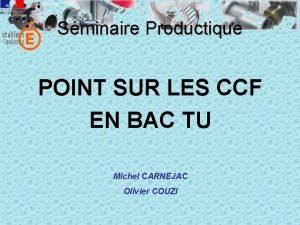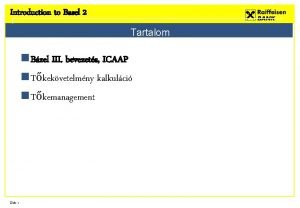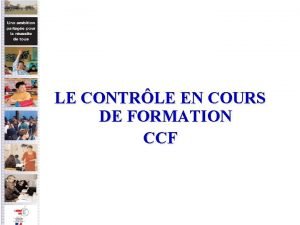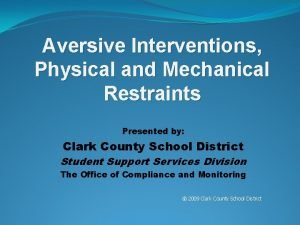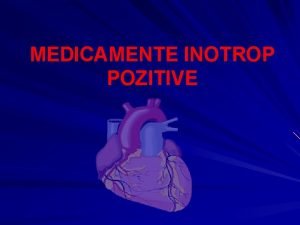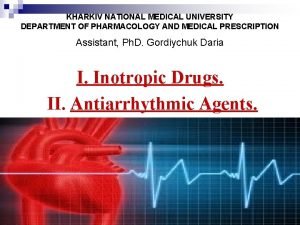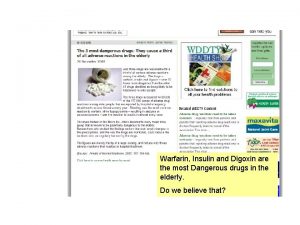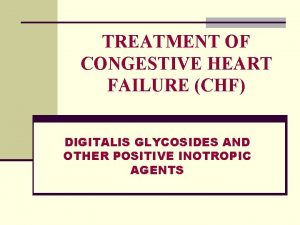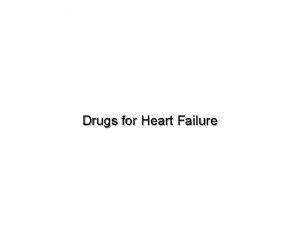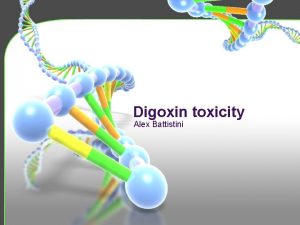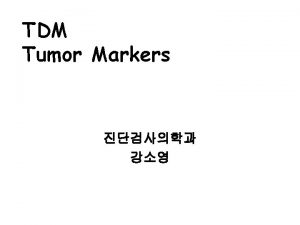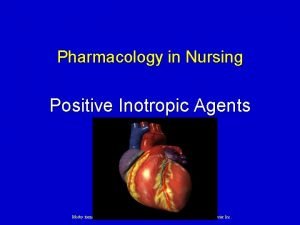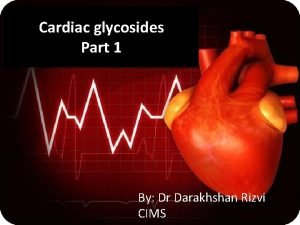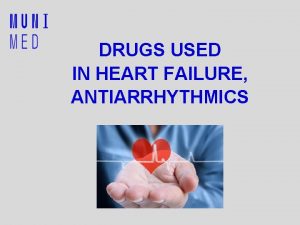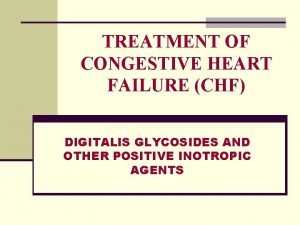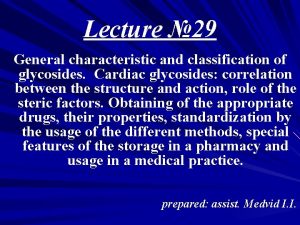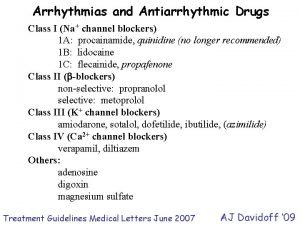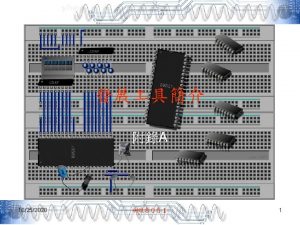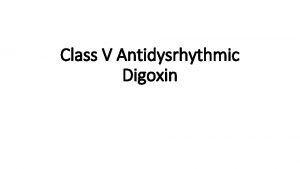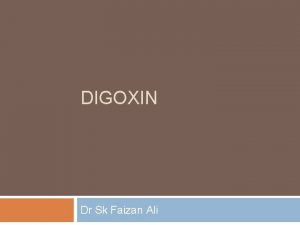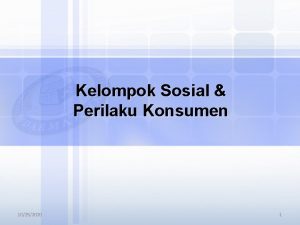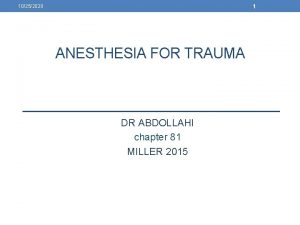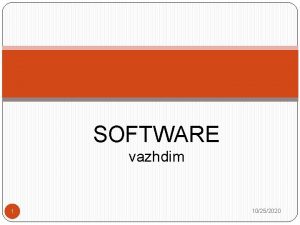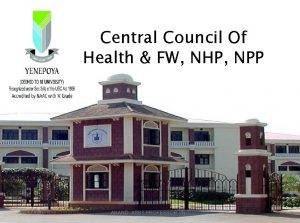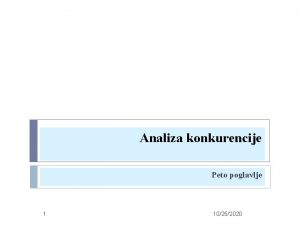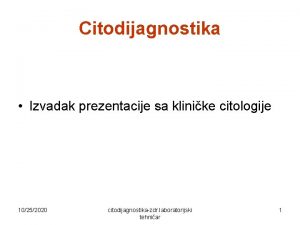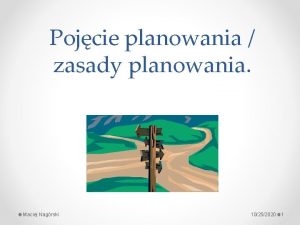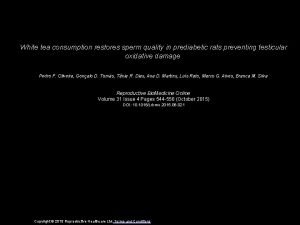Digoxin in CCF 10252020 21 Digoxin It restores













































- Slides: 45





















Digoxin in CCF 10/25/2020 21

Digoxin It restores the vagal tone and abolishes the sympathetic over activity Increase the refractoriness of AV node thus decrease ventricular response to atrial rate First-line drug in patients with CHF who are in atrial fibrillation. 10/25/2020 22

Digoxin Adverse effects / Precautions : Nausea, vomiting, gynecomastia, visual disturbances and psychosis. Ventricular bigeminy, AV block and bradycardia. Amiodarone and verapamil can increase the plasma concentration of digoxin by inhibiting its excretion 10/25/2020 23

Digoxin Toxicity treatment Toxicity can be treated with higher than normal doses of potassium Digoxin antibody (digibind) is used specifically to treat life-threatening digoxin overdose 10/25/2020 24


Dobutamin B 1 -adrenergic agonist receptors Giving it a prominent inotropic action on the heart Some α- and B 2 -agonist properties Structurally related to dopamine It has no specific dopaminergic properties; however, like dopamine, the inotropic action of dobutamine on the heart is associated with less cardiac-accelerating effect than that of isoprenaline 10/25/2020 26

Dobutamin Uses Increase the contractility of the heart in acute HF, as occurs in cardiogenic shock and MI Septic shock Its inotropic activity may be useful are during cardiac surgery 10/25/2020 27

Dobutamin In the management of acute HF, is given at a usual rate of 2. 5 to 10 µg/kg/min, according to the patient's heart rate, blood pressure, cardiac output, and urine output A range of 0. 5 up to 40 µg/kg/min has occasionally been required It has been recommended that treatment with dobutamine should be discontinued gradually 10/25/2020 28

Dobutamin Preparation IV infusion as a dilute solution (0. 25 to 5 mg/m. L), in glucose 5% or sodium chloride 0. 9% Other fluids may also be suitable and the manufacturers' guidelines should be consulted. 10/25/2020 29

Adverse Effects & Treatment Dobutamine has mainly B 1 -agonist properties and its principal adverse effects include: Dose-related increases in HR and blood pressure, ectopic beats, angina or chest pain, and palpitations Dosage should be reduced or temporarily stopped if they occur Ventricular tachycardia may occur rarely 10/25/2020 30

Dobutamin Incompatibility Alkaline solutions such as sodium bicarbonate 5% and alkaline drugs such as aminophylline, furosemide, and thiopental sodium Physical incompatibility with calcium gluconate, insulin, diazepam, and phenytoin has also been suggested There have also been reports of incompatibility with alteplase, heparin, and warfarin sodium 10/25/2020 31

Dopamine Catecholamine sympathomimetic with both direct and indirect effects It differs from Ep and Nep in dilating renal and mesenteric blood vessels and increasing urine output, apparently by a specific dopaminergic mechanism 10/25/2020 32

Uses and Administration Dopamine is used in acute HF, as occurs in cardiogenic shock and myocardial infarction In renal failure (under Surgery and Intensive Care), in cardiac surgery, and in septic shock 10/25/2020 33

Pharmacokinetics The vasoconstrictor properties of dopamine preclude its use by the SC or IM route Like Ep it is inactive when given orally, and it is rapidly inactivated in the body by similar processes, with a t ½ ~ 2 min Dopamine is a metabolic precursor of Nep and a proportion is excreted as the metabolites of Nep The majority appears to be directly metabolised into dopamine-related metabolites 10/25/2020 34

Adverse Effects and Treatment Dopamine may have adverse effects relating to both its α- and B-agonist properties: Dopamine has a short duration of action Most adverse effects respond to discontinuing or reducing the rate of infusion Infiltration with phentolamine may relieve pain and prevent necrosis following extravasation 10/25/2020 35

Dopamine Preparation Dopamine is given as the hydrochloride by IV infusion as a dilute solution (usually 1. 6 or 3. 2 mg/m. L, although more dilute solutions may be used where fluid expansion is not a problem), in glucose 5%, sodium chloride 0. 9%, or other suitable diluents 10/25/2020 36

Dopamine Incompatibility Inactive in alkaline solutions such as sodium bicarbonate 5% and is incompatible with alkaline drugs such as furosemide and thiopental sodium Incompatibility with insulin and with alteplase The manufacturers state that it is incompatible with ampicillin and with amphotericin B, and that mixtures with gentamicin sulfate, cefalotin sodium, or oxacillin sodium should be avoided 10/25/2020 37




Diuretics These are useful in reducing the symptoms of volume overload by Decreasing the extra cellular volume Decreasing the venous return 10/25/2020 41

Diuretics Loop diuretics like furosemide and bumetanide are the most effective and commonly used Thiazides are effective in mild cases only 10/25/2020 42

Diuretics Adverse effects: Loop diuretics and thiazides cause hypokalemia Potassium sparing diuretics help in reducing the hypokalemia due to these diuretics 10/25/2020 43

Spironolactone Aldosterone inhibition minimize potassium loss, prevent sodium and water retention, endothelial dysfunction and myocardial fibrosis. 10/25/2020 44

Spironolactone Aldosterone antagonist Spironolactone can be added to loop diuretics to modestly enhance the diuresis; more importantly, improve survival. 10/25/2020 45
 Restore my soul quotes
Restore my soul quotes Point ccf
Point ccf Bts tourisme coefficient
Bts tourisme coefficient Andrea beyer cleveland clinic
Andrea beyer cleveland clinic Basel 3
Basel 3 Ccf définition
Ccf définition Ccf in library science
Ccf in library science Nihr ccf
Nihr ccf When may a ccsd employee use an aversive intervention
When may a ccsd employee use an aversive intervention Intoxicatie digitalica
Intoxicatie digitalica Dromotropic meaning
Dromotropic meaning Digoxin toxicity level
Digoxin toxicity level Digoxin and warfarin
Digoxin and warfarin Digoxin uses
Digoxin uses Digoxin toxicity mnemonic
Digoxin toxicity mnemonic Digoxin moa
Digoxin moa Cheonotropic
Cheonotropic Cardioactive drugs
Cardioactive drugs Dromotropy
Dromotropy Dromotropic effect
Dromotropic effect Cardiogenic shock
Cardiogenic shock Use of foxglove
Use of foxglove Digitoxin and digoxin
Digitoxin and digoxin Safest antiarrhythmic drug
Safest antiarrhythmic drug

